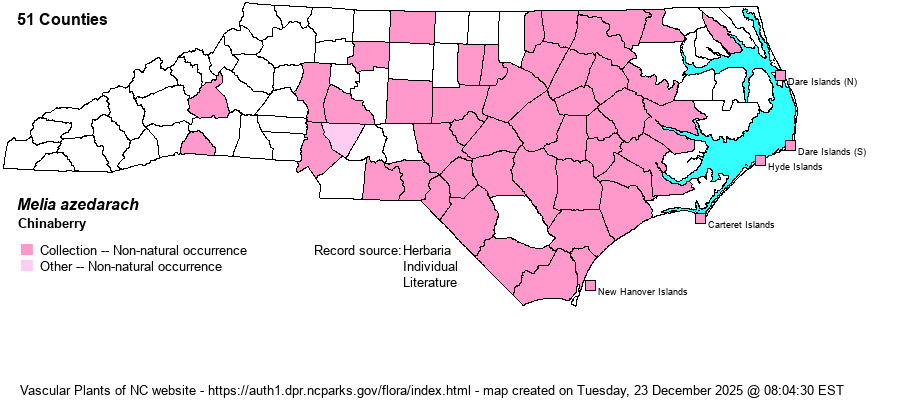| Author | L. | |
| Distribution | From the Outer Banks through the Piedmont; also McDowell and Polk counties in the foothills.
Native of southeastern Asia; in N.A. in the southern portion of the U.S.: VA to FL-TX-CA. | |
| Abundance | Frequent to common in the Coastal Plain and eastern Piedmont, uncommon on the Outer Banks and most of the Piedmont; rare in the foothills. Planted extensively and persisting in yards or freely escaping. | |
| Habitat | Fields, woodland borders, roadsides, old home places, disturbed land. Though it can be common, it tends to remain along borders of woods and usually does not escape into the shade of forests to become a pest species. | |
| Phenology | Flowering April-May; fruiting September-October. | |
| Identification | Chinaberry is a small to medium tree with a full crown. Leaves are large and compound, divided into 3 or so pairs of opposite leaflets, each leaflet divided into 3-4 pairs of opposite sub-leaflets plus a terminal one. The sub-leaflets are ovate, taper-tipped, and serrated on the margins. The flowers grow in large, open panicles with 5 pale lavender-pink, slender petals that have a maroon center. Fruits are rounded capsules -- looking like berries, generally light to medium orange, persisting on the tree into winter -- and easily identifying such a tree at a distance even without any leaves. | |
| Taxonomic Comments | | |
| Other Common Name(s) | | |
| State Rank | SE | |
| Global Rank | GNR | |
| State Status | | |
| US Status | | |
| USACE-agcp | UPL link |
| USACE-emp | UPL link |

